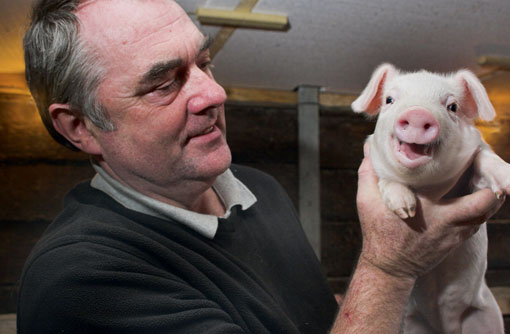Welsh pigs making a comeback
A farmer who runs a third of the remaining pedigree Welsh pig breeding herd says the breed is making a comeback as producers recognise its potential for supplying niche markets.
Welsh pig numbers plummeted when farmers turned to hybrid breeds, and there are now just 500 breeding sows in the UK.
But one farmer, Ken Austin, is leading a resurgence of this breed and hopes to establish a semen bank to boost numbers.
Mr Austin has 165 breeding Welsh pigs on his Gower farm; within 12 months he will have built up a herd of 200 sows.
“Because numbers are so low I have been selecting the best I can from around the country and have established a breeding pool to help other farmers build up numbers,” he says. His herd includes all 25 female and 11 male lines. There are 750 Welsh pigs on the farm at present.
Mr Austin first kept Welsh pigs at Burry Dairy Farm, Reynoldston, in the 1970s when, along with the Large White, it was the most popular breed. In 1977 he clinched the female pig championship at the Royal Show from an entry of 800 pigs.
But as the popularity of hybrids grew, so Welsh pig numbers diminished. In the 1980s Mr Austin was forced to sell his herd after illness prevented him from looking after the animals.
But 18 months ago when he read an article on Welsh pigs being placed on the list of endangered species, he decided to build up a herd once more.
His decision was based on business sense rather than sentimentality. “I feel there is such a future for the Welsh pig. They tick all the right boxes, from their good mothering ability to the taste of the meat,” he says.
Mr Austin has never used farrowing crates and says he has never needed to. “Years ago sows on Welsh farms had to farrow in a shed, this was bred into them. I don’t think any animal should just sit in a crate,” he says.
The sow produces good volumes of milk and the piglets, which get sow and weaner feed from three weeks, grow very quickly. They are sold at 20 weeks at between 85kg-95kg.
When the piglets are three weeks old, they are grouped with their mothers in batches of up to six sows. “The quickest way to get the piglets feeding is for them to eat with their mothers so they get sow feed from an early age,” says Mr Austin.
The piglets are weaned at six weeks into groups of between 40 and 60, depending on pen size, and are fed grower pellets. At 10 weeks they are transferred into finishing pens and are slaughtered at a Freedom Foods-approved abattoir in Gloucester at 20 weeks.
Mr Austin says his system is well suited to the RSPCA-run Freedom Foods scheme, which rewards him with a premium on his meat. He is the first and only Freedom Foods pig producer in Wales and markets his meat under The Welsh Farmyard brand. “It is all down to the comfort of the animal and that’s an area we have always looked after,” he says. “The only things we had to change to meet the criteria were to produce health plans and to introduce rodent controls.
“I don’t see Freedom Foods as being beyond the reach of any farmer if they are doing what they should be doing.”
The breeding gilts are selected at 20 weeks. A key criteria is that they must have a minimum of 14 teats, seven on each side. The breeding stock get a diet of sow meal and silage and are turned out into the fields in the summer.
Mr Austin plants four acres of cabbages in June which the pigs graze in the winter. He plans to increases this acreage and to grow swedes and turnips too. The sows, he says, pick up minerals from the soil and for that reason their fertility is good. “The sows go through the soil and find what they need,” he says. “We would expect 10 piglets from a first gilt and a second litter of 13.” The sows produce five litters within a two-year period. “Intensive systems may get more piglets for every sow but they won’t be getting a premium,” he says.
Mr Austin is currently negotiating with a supermarket interested in using only his pigs to supply all its Welsh stores. If the deal comes off he would supply a minimum of 30 pigs a week. “The buyers have tasted the meat and are very impressed with it. It came out way ahead of others for tenderness, taste and its cooking qualities,” he says. “They might have more fat than hybrids, there would be a backfat probe of 11 for Welsh pigs compared to eight for hybrids, but that’s what helps it to cook.”
Mr Austin says his membership of an Agrisgôp group led by Huw Davies, an initiative within the Welsh Assembly Government’s Farming Connect programme, has enabled him to gain greater understanding of the food chain. This has helped him see the potential for marketing his pigs as a high welfare, locally-branded product.
Mr Austin now wants to team up with a breeding technology company to help other farmers build up numbers. “We want to establish a nucleus pool under a controlled breeding programme which we can do because we have all the family lines,” he says. “In some of the families there are only two or three sows left, if we don’t look after them they will die out.”

